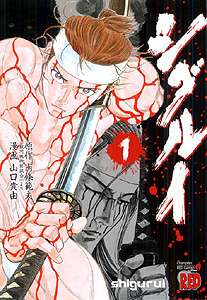Shigurui
| Shigurui | |
 Cover of the first volume of Shigurui | |
| シグルイ | |
|---|---|
| Genre | Chanbara |
| Manga | |
| Written by | Takayuki Yamaguchi |
| Published by | Akita Shoten |
| Demographic | Shōnen, Seinen |
| Magazine |
Champion Red (2003−2006) Champion Red Ichigo (2006−2010) |
| Original run | 2003 – 2010 |
| Volumes | 15 |
| Anime television series | |
| Shigurui: Death Frenzy | |
| Directed by | Hiroshi Hamasaki[1] |
| Written by | Seishi Minakami |
| Studio | Madhouse |
| Licensed by | |
| Network | WOWOW |
| Original run | July 19, 2007 – October 12, 2007 |
| Episodes | 12 |
Shigurui (Japanese: シグルイ, lit. "Death Frenzy") is a Japanese manga series by Takayuki Yamaguchi, based on the first chapter of the novel Suruga-jō Gozen Jiai by Norio Nanjō. The series is noted for its realistic graphic violence and nudity as well as its abrupt ending. An anime television adaptation, based on the first 32 chapters (or the initial six and a half volumes) of the manga, aired on WOWOW from July 19 to October 12, 2007. The series was directed by Hiroshi Hamasaki, written by Seishi Minakami, and produced by Madhouse Studios. The anime was licensed in North America by Funimation under the fully translated title Shigurui: Death Frenzy. The licensing was announced in May 2008[2] and the full series was released on March 31, 2009 on Blu-ray and DVD.
Plot
The story begins in 1629 Shizuoka during Tokugawa Tadanaga's rule. The daimyo staged a tournament where the participants fought with real steel Japanese swords rather than bokken ("wooden sword"), against his vassals' strong objection. The story revolves around the first match between the one-armed swordsman Fujiki Gennosuke and the blind samurai Irako Seigen and deals with the circumstances that led the two to participate in Tokugawa's tournament.
Characters
- Gennosuke Fujiki (藤木 源之助 Fujiki Gennosuke)
- Voiced by: Daisuke Namikawa (Japanese); John Burgmeier (English)
- The stoic star pupil of the Kogan dojo. In the present time in his duel with Seigen he has only one arm but it is noted that his back muscles could theoretically make up for lost strength. Fujiki is very loyal to Kogan (his master), and is said to be most likely to succeed as the school's master.
- Seigen Irako (伊良子 清玄 Irako Seigen)
- Voiced by: Nozomu Sasaki (Japanese); J. Michael Tatum (English)
- An ambitious man who seeks to raise his status. In the present time, he is blind and has a deep cut in one of his feet. Years before, he joined the Kogan-Ryuu school afterwards and was eventually picked to become the successor over Gennosuke Fujiki, but he and Kogan had a falling out which resulted in his present-day blindness.
- Gonzaemon Ushimata (牛股 権左衛門 Ushimata Gonzaemon)
- Voiced by: Yūsaku Yara (Japanese); R. Bruce Elliott (English)
- A master of the Kogan-Ryuu school and Gennosuke's senior. A hulk of a man, Ushimata uses an immensely large wooden sword (Seigen comments that appears to be a Suburitō) which he wields with ease.
- Kogan Iwamoto (岩本 虎眼 Iwamoto Kogan)
- Voiced by: Seizō Katō (Japanese); Jerry Russell (English)
- The Grandmaster of the Kogan-Ryuu school. Mentally unbalanced most of the time, he regains his sanity most often in the period between fall and winter. Kogan cares nothing for his daughter, Mie, seeing her only as a tool to continue his bloodline. He has a small deformity, a sixth finger on one of his hands. His technique "Nagare Boshi" (Shooting Star) is known and feared by many Samurai.
- Mie Iwamoto (岩本 三重 Iwamoto Mie)
- Voiced by: Hōko Kuwashima (Japanese); Laura Bailey (English)
- The daughter of Kogan Iwamoto.
- Lady Iku (いく Iku)
- Voiced by: Emi Shinohara (Japanese); Wendy Powell (English)
- The concubine of Kogan. When she was younger she was consistently taunted with a Children's Song and the masses fled at her approach. This public scorn only increased her dependence on her husband.
Media
Manga
Anime
The series was adapted into a 12-episode anime series by Madhouse Studios and broadcast on WOWOW from July 19 to October 12, 2007. The series was directed by Hiroshi Hamasaki and written by Seishi Minakami. Funimation licensed the series for release in North America. The series was later added to iTunes.[3]
References
External links
- Shigurui at Funimation
- Shigurui (manga) at Anime News Network's encyclopedia